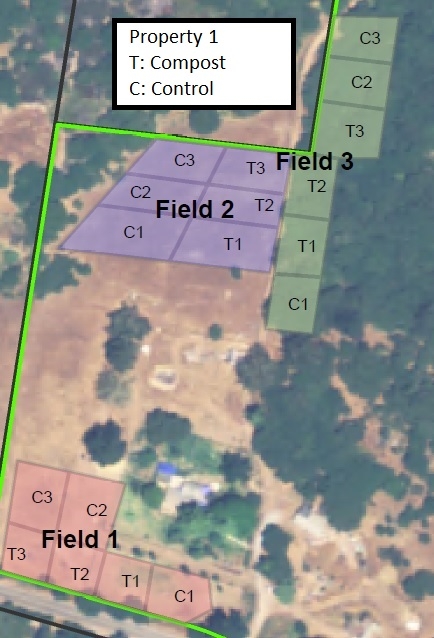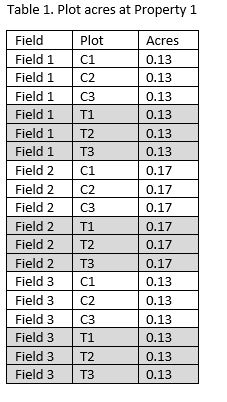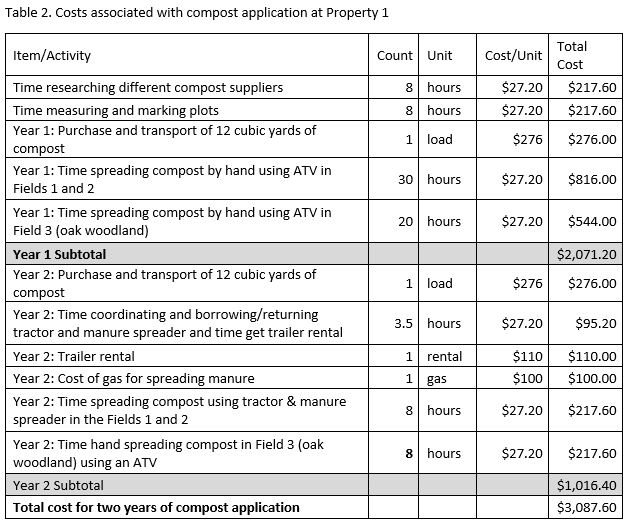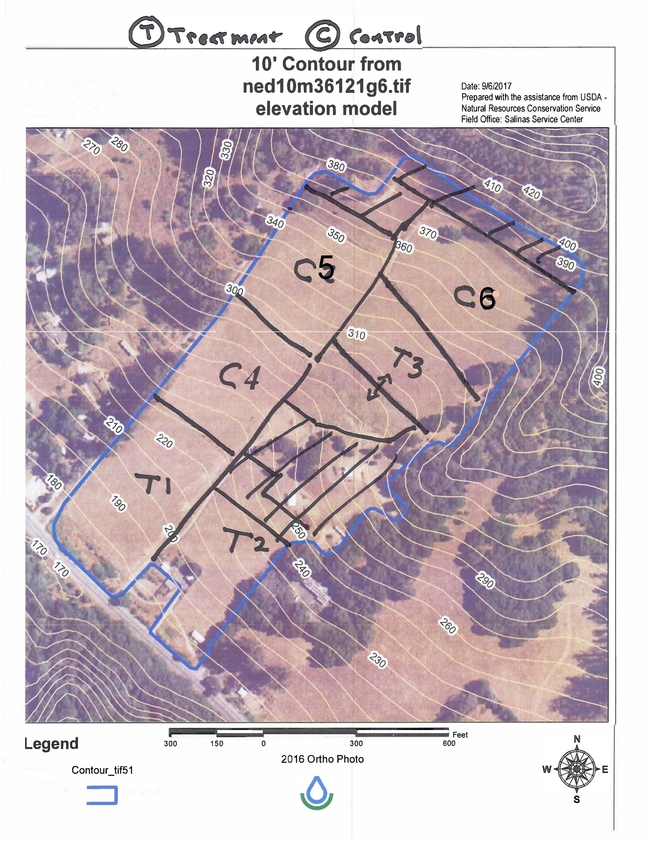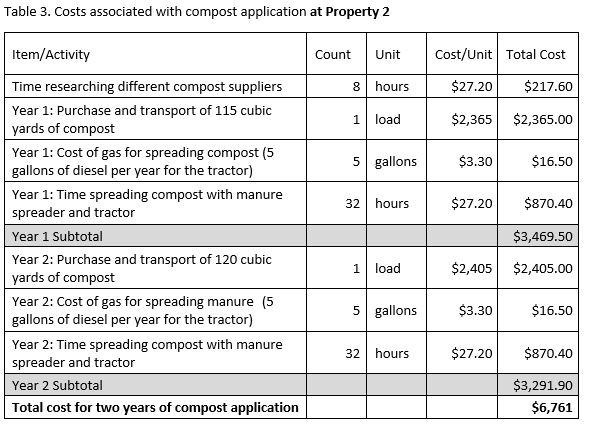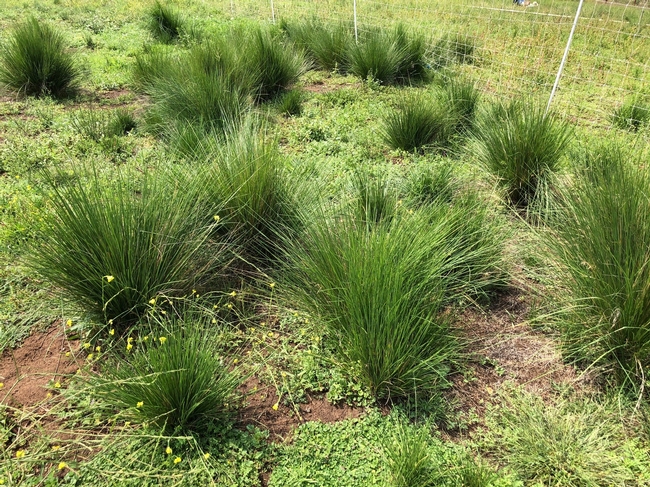
Pam Krone, Agriculture Water Quality Coordinator with California Marine Sanctuary Foundation/Monterey Bay National Marine Sanctuary received a Healthy Soils grant from the California Department of Food and Agriculture (CDFA) in spring 2018 to increase carbon sequestration in the soil while also supporting farming and ranching operations. One of the primary activities of this grant was applying compost to grasslands in order to increase carbon sequestration. Grant activities took place over three years from 2018-2020. Compost was spread two years in a row (December 2018 and November 2019) at two properties in coastal Monterey County at a rate of 4 dry tons per acre. The third and final compost application will be in fall 2020. This article calculates the costs associated with spreading compost for two years on grasslands and an oak woodland at these two sites (identified as Property 1 and Property 2).
General Costs
Cost that went into compost application included time costs and cash costs. Costs related to time included time spent researching local compost companies, setting up the plots, and spreading the compost. Cash costs included cost of the compost, transportation of compost to the property, and equipment for spreading compost. For this article I used $27.20/hour as the value of people's time. This number comes from the Independent Sector volunteer rate for July 2020.
Pam noted that there are many different locations for compost on the Central Coast. Some companies charge by the mile to deliver. Some have a set price per ton or cubic yard delivered. Others will provide contact information for delivery services if they cannot deliver themselves. Pam found that it was more economical to go with a supplier who would also provide the delivery and include the delivery price in the overall compost cost. Another finding was that different suppliers have different spreading equipment. And some are more particular about only spreading on flat even ground, while others are more flexible about spreading on uneven or slightly sloped terrain.
Regular cost for compost, delivery, and spreading ranges from $45-$62/ton, depending on what kind of compost is purchased, whether it is certified organic, distance to the property from the compost company, and steepness and evenness of the field. Most companies deliver the compost and do not let people come pick up the compost themselves. Cost for spreading ranged from $7 - $12/ton on flat ground (spreading cost is included in the $45-$62/ton figure above). Costs are higher for spreading compost on steeper land. The Healthy Soils grant program only paid $35/ton for compost. Pam was able to negotiate with the compost companies to get a reduced rate so the grant covered all the compost costs. However, at least one company took a loss, so reduced rates are probably not going to be available the future.
Costs for Property 1
Property 1 is a 17-acre farm that runs sheep, pigs, and chickens. There are eighteen plots across three fields on this ranch (Figure 1), half of which received the compost treatment (labeled as T1, T2, and T3) and half of which were control plots (labeled as C1, C2, and C3), not receiving the compost treatment. Field 1 is grassland and was broadcast seeded with an LA Herne dryland pasture mix in January 2020. Field 2 is an unseeded open grassland, and Field 3 is an oak woodland. Table 1 lists acreage for each plot. Compost was spread across a total of 1.29 acres at Property 1.
Figure 1. Map of Property 1
The rancher for Property 1 wanted compost without manure content in order to minimize the application of phosphorus, as chicken and goat manure were already present from grazing the fields. Organically certified compost made from green waste was selected. In 2018 an ATV pulling a small trailer was used for compost addition. The compost was hand shoveled into the trailer, taken to the plots, dropped out the trailer back gate, and raked to achieve even coverage. The time to accomplish this task (approximately 50 hours) lead the rancher to seek an alternative application method the second year. In 2019 the rancher was able to borrow a tractor and manure spreader from a nearby ranch, but had to rent a trailer in order to transport this equipment. The tractor and manure spreader were used for compost application to Fields 1 & 2, which are open grassland and the spreading task was accomplished in one day. Field 3 is an oak woodland and the ATV and trailer were used again for this field. However, the tractor shovel was used to fill the trailer, rather than hand shoveling, and the compost spreading task for Field 3 was accomplished in 8 hours. Table 2 shows costs associated with compost application at Property 1.
Costs for Property 2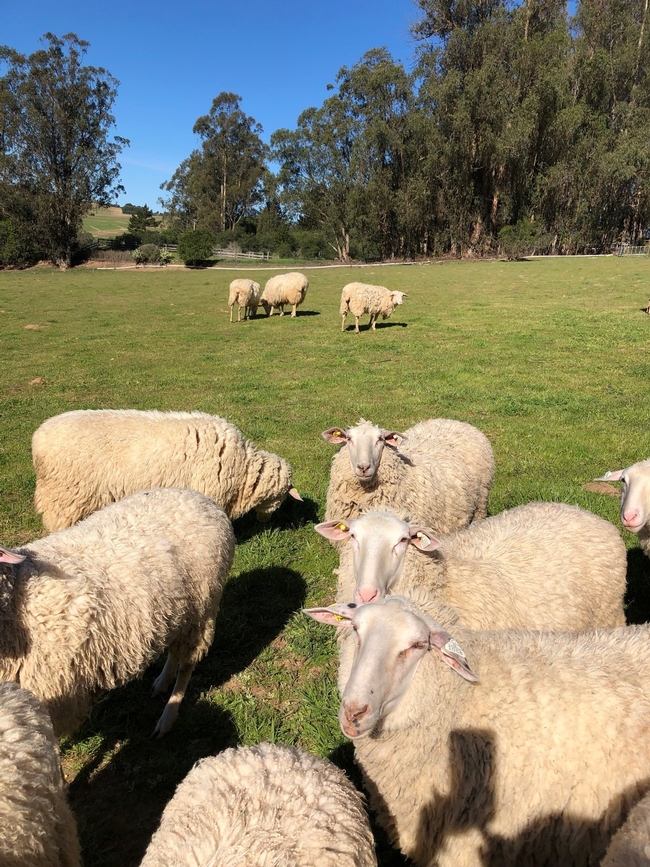
Property 2 is a 38-acre property with sheep and pigs. There were six plots covering 24 acres on this ranch (Figure 2). Plots T2 and C6 were irrigated in 2018. Plots T2 and T3 were irrigated in 2019. Plot T2 was irrigated in 2020. Irrigation occurred one day per week for 4 hours (spaced out at two 2-hour intervals). Irrigation in 2018 and 2019 started in June and was continued through October. In 2020 irrigation began in June and continued through now (end of September). Compost was added to three treatment plots: T1, T2, and T3. The three control plots did not receive compost: C4, C5, and C6. Plots are approximately equal in size, as specified by the CDFA grant, each covering about 4 acres for a total area of 12 acres receiving compost at Property 2. Table 3 shows costs associated with compost application for Property 2. The compost company that Property 2 went with would not spread the compost because the slope was too steep. The owners of Property 2 have a tractor and manure spreader that was used for the compost application.
Figure 2. Map of Property 2
One of the anticipated benefits of compost addition is higher forage production. Peak standing biomass was measured on all plots at both properties in the spring of 2018 (prior to compost application), 2019, and 2020. However, forage production was not measured in Property 1 Field 3 in 2020 because there was too much poison oak. Based on these measurements, biomass increased on all compost plots and decreased on all control plots after compost application. It is important to note that increased forage production may or may not be a direct cause of the compost application. Other factors such as weather, irrigation, and seeding can substantially influence forage production. Interestingly, forage production in the control plots decreased. It is typical for forage production to change each year, depending on timing and amount of rain. If the increase in forage production on the compost plots was due to weather, it would be expected that forage production on the control plots would increase as well, but this did not occur. Therefore, it is reasonable to hypothesize that the increase in forage production on the compost plots was due to the compost application.
The owner of Property 1 noted that there was one unidentified tall plant (not a grass) that grew only on the plots where compost was applied. And the owner of Property 2 observed that the compost fields were more lush and stayed green for longer. A research project with an appropriate experimental design would be required to understand the value of compost in improving forage production.
Author - San Benito County Director and Area Livestock and Natural Resources Advisor
